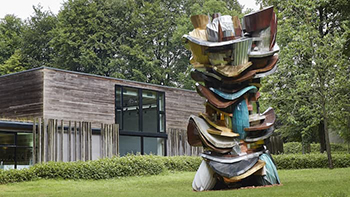
In 2009, the Chinese-American artist Jennifer Wen Ma took over a pottery kiln in Japan’s Niigata prefecture.
2009年,美籍华裔艺术家马文(Jennifer Wen Ma)接手了日本新泻县(Niigata)的一个陶瓷窑。
For her piece You Can’t Always See Where You Are Going, But Can You See Where You’ve Been?, she flooded the sloping chambers of the kiln with black ink, and then drenched the surrounding vegetation in the pigment.
在她的作品《你不会总知道自己将去何方。但是你知道自己去过哪里吗?》(You Can’t Always See Where You Are Going, But Can You See Where You’ve Been?)中,她把倾斜的窑炉中灌满黑色墨水,之后把周围的植被染上颜色。
Since then Ma, who began her career as an oil painter but soon found the discipline of ink wash increasingly attractive, has repeatedly revisited a vision of the world as an ink painting.
自那之后,她从水墨画的角度不断重新审视这个世界。马文以油画画家的身份开始职业生涯,但她很快发现自己越来越着迷于水墨的魅力。
Ink is used to fill reflective pools in Ma’s latest installation, Molar, which lies at the heart of the Cass Sculpture Foundation’s A Beautiful Disorder exhibition.
在马文最新的装置作品《蕴》(Molar)中,墨水被用于填满反光池。该作品在卡斯雕塑基金会(Cass Sculpture Foundation)的无序之美(A Beautiful Disorder)展览中处于中心位置。
From the ground up, an inky landscape takes shape: the pitch-black liquid coalesces in wells, whose surfaces acquire a strange, impure sheen as the ink’s mineral-rich content floats to the surface.
从地面往上,一个立体的水墨景观出现在人们眼前:井中充满漆黑的液体,墨水中富含矿物质的成分漂浮在表面上,形成一层怪异、不纯的光泽。
Even the air takes on the fragrance of the pigment.
就连空气中也散发着颜料的香味。
Ma places glowing glass orbs in the ink pools, then marks the enclosure with glass panels bearing ink paintings of the surrounding West Sussex countryside.
马文在墨水池中放入发光的玻璃球,然后用带有周围的西萨塞克斯郡(West Sussex)乡村风景水墨画的玻璃面板把池子围起来。
From the ceiling, a tree bursts through, its foliage coated black with ink, sprouting cancerous, crystalline fruit.
从屋顶看,一棵树从中穿过,叶子用墨水涂黑,树上长着肿瘤一般的晶体果实。
These 400 hand-blown glass pieces contain teardrop-shaped, sperm-like structures, as well as voluptuous fertility symbols, while others have mutated into malignant cell-like forms.
这400个人工吹制的玻璃制品包含泪滴形、精子形,同时还有象征着生育能力的饱满形状,而还有一些果实突变成恶性肿瘤般的形状。
As in traditional Daoist thought, the internal workings of the human body here become a microcosm of the wider natural world.
就像传统的道家思维,人体的内部构造在这里成了整个自然界的缩影。
For this exhibition, Cass has invited young artists from the Greater China region to create installation pieces across its extensive grounds, covering light woodland and open fields, as well as indoor gallery space.
对于此次展览,卡斯邀请了来自大中华区的年轻艺术家,在整个宽阔的场地(包括明亮的树林和开阔田野,还有室内展示空间)创作装置作品。
In doing so, it has recorded a search for what the French Jesuit painter Jean Denis Attiret, a missionary to China in the 18th century, called the beautiful disorder of Chinese landscape aesthetics.
这样一来,它记录下一个搜寻过程,目标是18世纪前往中国的耶稣会传教士、法国画家王致诚(Jean Denis Attiret)所称的中国景观美学中的无序之美。
His description was echoed by another western visitor to China at the time, the architect William Chambers, for whom the Chinese garden created violent or opposing sensations: a container for the pleasing, the terrible and the surprising.
这一描述得到了另一位在同一时期前往中国的西方人、建筑学家威廉•钱伯斯(William Chambers)的赞同。对钱伯斯而言,中国园林创造了暴力或者对立的感觉:融合了愉悦、糟糕和惊喜。
A Beautiful Disorder makes extensive use of the principle of jiejing, or the borrowed view, in which the extended landscape is brought into view to create a provocative framing for each sculpture, from the micro-level in Zhang Ruyi’s Pause, where a stretch of woodland is studded with tiny electrical sockets, through to Cui Jie’s Pigeon’s House, in which the artist builds a tower out of architectural motifs from Beijing’s urban landscape, overlooking an English pastoral expanse.
无序之美大量运用了借景的手法,把延伸的景观引入视野,为每座雕塑创建一个引人入胜的框架,无论是张如怡的作品《暂停》中的微观层面(微小的电源插座散布在一片林地)、还是崔洁的《鸽子的房子》(艺术家根据北京城市景观的建筑特色建造了一座塔楼,俯瞰着英格兰的无垠田园)。
It also traces the ways in which Chinese sculpture and installation art often revolve around a sensation of boundaries becoming corrupted and twisted.
该展览还延续了中国雕塑和装置艺术往往围绕一种濒临颓废和扭曲的边缘感觉的方式。
For the artist Cheng Ran, for example, the sculpture park’s patches of woodland offer possibilities for probing the edges of psychological states.
例如,对艺术家程然来说,雕塑公园内的林地提供了探索心理状态边缘的可能。
Born in Inner Mongolia in 1981, Cheng is better known for his trance-like video art, where he remixes Hollywood film and Korean soap operas.
程然1981年出生于内蒙古,他更为人熟知的是迷幻风格的视频制作艺术(对好莱坞影片和韩剧进行混编)。
Yet he has always been fascinated by the natural world’s capacity for provoking hypnagogia — a state between dreaming and waking.
不过,他总是着迷于自然界引发半梦半醒(hypnagogia ,一种介于做梦和清醒之间的状态)的能力。
In his surreal 2009 video The Sorrows of Young Werther, Cheng portrayed a midnight forest, which he then interrupted with explosions of colour using suspended mirrored spheres and disco balls.
在2009年制作的超现实主义视频《少年维特之烦恼》(The Sorrows of Young Werther)中,程然营造了一个午夜森林的环境,然后用悬挂的镜面球体和迪斯科球灯的强烈色彩打破了静谧。
In his piece Crossroads here, Cheng has reversed the idea, after studying the pattern of sunlight and shade in the woodland.
在研究了树林中光和影的模式后,他在作品《十字路口》中逆转了那种创意。
He uses scaffolding to hoist up a light which perpetually bathes the trees in artificial, dappled sunlight, creating another kind of dream-space.
他用脚手架支起一盏灯,使树木沐浴在斑驳的人造光线中,营造出另一种梦境。
The development of contemporary art in mainland China can be distinguished from that of the west through what the University of Chicago art historian Wu Hung has called a pattern of rupture.
与西方当代艺术不同的是,中国内地当代艺术的发展被芝加哥大学(University of Chicago)的艺术史学家巫鸿(Wu Hung)称为隔断模式。
He suggests that Chinese history has been subject to a series of violent political and ideological fractures, with the result that artists are in a state of constant reorientation.
他认为,中国历史经历了一系列剧烈的政治和意识形态上的断裂,结果就是艺术家处于不断重新定位的状态。
The potential of past ideologies to become strange and alien is taken up in Wang Yuyang’s Identity.
王郁洋在其作品《特性》中探索了昔日的意识形态变得奇怪而异化的可能。
Wang has converted Karl Marx’s Capital into binary code, and then fed it into 3D rendering software which produced construction and material calculations for the artist.
他把卡尔•马克思(Karl Marx)所著的《资本论》(Capital)转化为二进制代码,而后把代码输入三维渲染软件,由其生成结构和为这名艺术家进行材料计算。
From that, Wang has produced a colossal fungus-like column of brass, steel and marble.
在此基础上,王郁洋制作了一个由铜、钢和大理石构成的巨型菌状柱体。
Song Ta’s performance-installation work Why do they never take colour photos? reflects even further on the mercurial qualities of China’s past.
宋拓的行为艺术装置作品《为什么他们从不拍彩色照片?》更深层次地表现了中国历史的剧变特点。
An enormous white bust of Chairman Mao has been placed in a seemingly post-apocalyptic grove of trees coated in lime-wash grey, in which students from a local theatre school skulk and dance.
毛主席的巨型半身雕像被置于看似后世界末日的树林(林干均被刷成石灰色)中,来自当地话剧学校的学生或是鬼鬼祟祟地出没其中,或是翩翩起舞。
The effect is of a profound rupture between past and present: gone are the images of workers and soldiers striding out from beneath the Chairman’s radiant gaze that used to adorn propaganda of the Maoist era.
作品凸显了过去与现在之间的深层次隔断:在毛主席像(曾在毛泽东时代用来宣传主旋律)的凝视下大踏步走过的工人和士兵的画面已经成为过去。
Until the turn of the millennium, the kinds of installation pieces hosted at Cass would have been relegated to the periphery by mainland China’s state-art system.
直到进入21世纪前,卡斯展出的装置作品一直被中国内地的国家艺术体系归为边缘艺术。
The art scene is now vastly different, and a surging generation of Chinese artists is seeking a globalised, cosmopolitan identity for itself, in contrast with the dominant national allegories of the past.
如今的艺术界风格迥异,与过去主导性的国家使命形成反差的是,新一代艺术家正在为自己寻找全球化、世界主义的身份认同。
But Chinese installation art has always carried the traces of impermanence.
但是,中国装置艺术一直带有无常的痕迹。
In a combination of shifting ink wash, the contours of the natural setting, and blockbuster installation artworks, A Beautiful Disorder teaches us to see these markers of displacement and transience even within the sedate confines of an English country estate.
在水墨、自然环境以及大型装置艺术作品的结合中,无序之美教会我们观察到置换和转瞬即逝的记号——即使是在静谧的英国乡村庄园。











